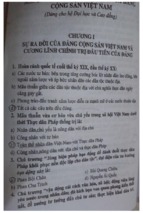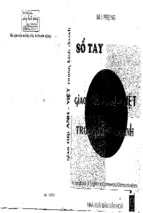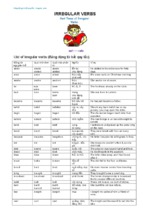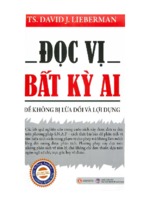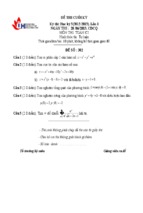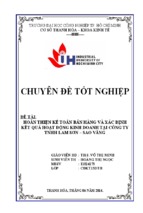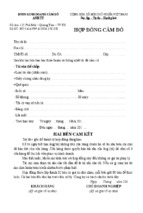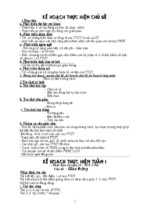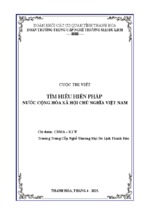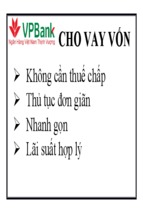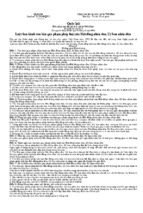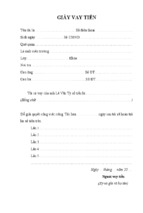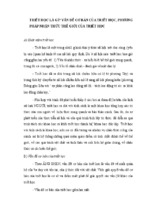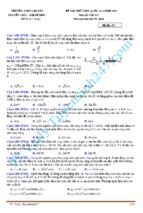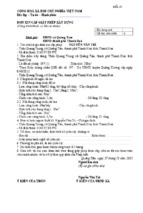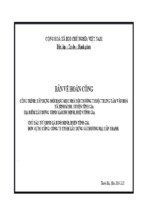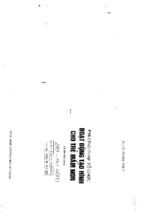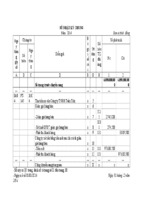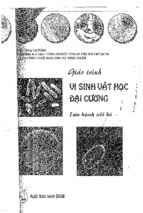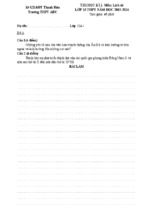MINISTRY OF EDUCATION AND TRAINING
HANOI OPEN UNIVERSITY
M.A Thesis
AN ANALYSIS OF THE USE OF INVERSION IN “JANE
EYRE”
PHÂN TÍCH CÁCH DÙNG ĐẢO NGỮ TRONG TIỂU THUYẾT
“JANE EYRE”
MAI THỊ HỒNG NHUNG
Field: English Language
Code: 8.22.02.01
Supervisor: Assoc. Prof. Dr. Ho Ngoc Trung
Hanoi - 2021
HANOI OPEN UNIVERSITY
1
M.A Thesis
AN ANALYSIS OF THE USE OF INVERSION IN “JANE
EYRE”
PHÂN TÍCH CÁCH DÙNG ĐẢO NGỮ TRONG TIỂU THUYẾT
“JANE EYRE”
MAI THỊ HỒNG NHUNG
Field: English Language
Code: 8.22.02.01
Supervisor: Assoc. Prof. Dr. Ho Ngoc Trung
Hanoi - 2021
2
CERTIFICATE OF ORIGINALITY
I, the undersigned, hereby certify my authority of the study project report entitled
AN ANALYSIS OF THE USE OF INVERSION IN “JANE EYRE”.
submitted in partial fulfillment of the requirements for the degree of Master in English
Language. Except where the reference is indicated, no other person‟s work has been
used without due acknowledgement in the text of the thesis.
Hanoi, 2021
MAI THỊ HỒNG NHUNG
Approved by
SUPERVISOR
Assoc. Prof. Dr. Ho Ngoc Trung
Date: ……………………
3
ACKNOWLEGEMENTS
I would like to express my appreciation to my supervisor, Assoc. Prof. Dr. Ho Ngoc
Trung, who has supported and helped me with his suggestions and insightful comments
all these months in this difficult undertaking of writing a Master Thesis.
My thanks also are sent to all the teachers of Ha Noi Open University who have taught
me with all their heart in unforgettable two years. They have directly or indirectly
contributed to the completion of this research.
I would also like to give my thanks to friends for their constructive opinions who
willingly participated in my study and became part of it. So that I could finish this paper
in time.
Last but not least, I must thank my family for the support they provided me during this
period.
Ha Noi, 2021
MAI THỊ HỒNG NHUNG
4
ABSTRACT
Inversion is a special grammatical phenomenon which is related to word order in
sentences. At the sentence level, inversion is strictly governed by syntactical rules. This
study aims to find out the use of inversion structure in the novel "Jane Eyre" by Bro nte
basing on the theoretical framework by Halliday and Hasan (1976). Firstly, the study
analyzed the use of inversion structure in novel Jane Eyre to be aware of the role of
inversion in discourse that the speakers emphasize their ideas in English. Secondly, the
thesis pointed out that inversion constructions help to create a fertile environment for
textual cohesion, where cohesive devices tend to be used for discourse connection.
Moreover, the thesis is a useful resource for businesses, employees, teachers, and
students who are interested in writing in the workplace and in communication and
overcoming these problems. There are 3 questions in the study. They are:
1. Which forms of inversion are used in “Jane Eyre”?
2. What are the discourse functions of English inversion in the novel?
3. What are some suggestions for studying inversion in English?
With the main methods are the descriptive method with quantitative and qualitative
approach. Quantitative method can involve collecting quantitative information, involves
gathering mass of raw data from different powerful sources. Furthermore, among
different types of inversion structure, subject – predicator inversion is accounted in this
novel with 111 cases and Subject – verb operator appears 394 times in the total, which
shows that the text is highly cohesive. The research findings show that inversion
structures are used in a very high rate to express the strong idea and connect the text
together as well as textual cohesion and thematic development. In other words, inversion
structures are used in the novel helps depict the writing style of literary documents in
general and of Jane Eyre in particular.
5
LIST OF ABBREVIATIONS
A
Adverbial
A. N
Negative adverbial
A only
Adverbial beginning with only
A place
Adverbial of place
Be
Be as verb
C
Complement
Op
Operator
Q-element
Clause element containing the Q- word
Q-word
Interrogative word
S
Subject
S1
The subject in the first clause
S2
The subject in the second clause
E.g
For example
Square brackets ( ) enclosing a number indicate the number of the example used
6
LIST OF TABLES AND FIGURES
Table 3.1 :
58
7
TABLE OF CONTENTS
Certificate o originality
i
Acknowledgements
ii
Table of contents
iii
Abstract
iv
List of abbreviations
v
List of tables and figures
Chapter 1: INTRODUCTION
1.1 Rationale
10
1.2 Aims and objectives of the study
11
1.3. Research questions
11
1.4. Methods of the study
12
1.5. Scope of the study
13
1.6. Significance of the study
14
1.7. Structure of the study
14
Chapter 2: LITERATURE REVIEW AND THEORETICAL BACKGROUND
2.1. Review of previous studies
15
2.2. Theoretical background
15
2.2.1. The concept of discourse
15
2.2.1.1 What is discourse?
15
2.2.1.2. Discourse versus text
16
2.2.1.3. Spoken and written discourse
17
+. Spoken discourse
+. Written discourse
2.2.1.4. Discourse and the sentence
19
2.2.1.5. The role of grammar in discourse
19
2.2.2. The concept of cohesion
20
2.2.2.1. What is cohesion?
2.2.2.2. Cohesion and coherence
20
2.2.2.3. Grammatical cohesion
21
8
2.2.2.4. Lexical cohesion
22
+ repetition
+ synonymy
+ contextual synonymy
+ meronymy
+ collocation
+ general words
2.2.3. The concept of inversion
23
2.2.3.1. What is inversion?
23
2.2.3.2. Operator
24
2.2.3.3. Inversion & Theme - Rheme structure
25
2.2.4. The role of inversion in discourse structure
27
2.2.5. Inversion as a source of cohesion in discourse
28
2.2.6. Stylistic features of inversion
28
2.3. Classification of Inversion
29
2.3.1 Subject – Verb Inversion
29
2.3.1.1 Inversion with the initial here
29
2.3.1.2. Inversion with the initial there
30
2.3.1.3. Inversion in reported speech
32
2.3.1.4. Inversion in formulae
33
2.3.1.5. Inversion with initial adverbials (of place)
33
2.3.2. Subject – operator inversion
34
2.3.2.1. Inversion in questions
34
2.3.2.2. Inversion in command with question tags
38
2.3.2.3. Inversion in exclamations
39
2.3.2.4. Inversion in statements
39
+ Inversion in sentence with ―if‖
+ Inversion after ―as‖
+ Inversion after ―neither, nor‖
+ Inversion after ―so‖
+ Inversion after adverbials with initial ―only‖
2.3.2.5 Inversion in negative adverbials
42
9
+ Inversion after ―Seldom, Rarely, Never‖
+ Inversion after adverbials containing the word ―No‖
2.4. Summary
44
Chapter 3: THE USE OF INVERSION IN “JANE EYRE”
3.1. Forms of inversion used in “Jane Eyre”
46
3.1.1. Subject – predicator inversion
46
3.1.2. Subject – operator inversion
48
3.1.2.1 In questions
48
3.1.2.2 In statements
52
3.2. The discourse functions of English inversion in the novel.
59
3.2.1. Creating anaphoric grammatical cohesion
59
3.2.2. Creating cataphoric grammatical cohesion.
60
3.2.3. Creating lexical cohesion
61
3.2.4. The dual function of the initial element.
64
3.2.5. The role of inversion in thematic development.
64
3.3. Implication of the study for the effective learning of inversion in English 66
3.4. Summary
67
Chapter 4: CONCLUSION
69
4.1. Recapitulation
69
4.2. Concluding remarks
70
4.3. Limitation of the research
71
4.4. Recommendations/Suggestions for further research
72
REFERENCES
73
10
Chapter 1: INTRODUCTION
1.1.
RATIONALE
Literature always plays an essential role in most people‟s spirit life. Though the
explosion of information and the revolution of high technology, especially the internet,
for a few recent decades, have given us various kinds of entertainments, literature still
one of the oldest and most favorite ways of entertaining, learning and experiencing life.
Besides, every literary works reflects authors‟ talents, one of that is the way they use the
language to express their ideas and to impress the readers. There are many ways the
writers have been using to make the language become such a valuable and flexible
means of transferring ideas. Sometimes, a simple way of forming a sentence or a bit
strange order of words can make the ideas become so impressive and unforgettable.
Inversion is one of those ways which creates great effects for literary works. Inversio n,
as it may seem, is simply a reversal of what is considered the normal or usual order of
the constituent parts. In fact, to English learners, it is not easy to understand and use
inversion correctly. Inversion is used a lot in English as well as Vietname se literature,
especially in literature works. Many writers prefer to use it as both a grammatical
structure and literary device because it is able to make readers come to the same idea
with new ways of approaching, so that things will seem to be new and more impressive.
Moreover, in order to use inversion in their works, the authors must take into account the
skill of using the language, how to organize and develop their writing. They must choose
the right sentences and ideas to apply this stylistic device that it will promote the best
effect, otherwise the sentences will be so tangled and difficult for the readers to
understand what the authors want to reveal. One strong motivation for my choice is the
fact that the use of inversion in literature has a great appeal to most of readers. Right
when readers look at a phrase or sentence in which there is a strange order of words (or a
group of words), they will think that there must be something special about this point
that the author wants them to notice. Therefore, inversion somehow immediately draws
readers‟ attention to the exact point that the writer emphasizes. Another interesting thing
about inversion is that there are grammatical rules for reversing words for phrases, but
many writers also create their own ways which often give stronger effect for being
unexpected. For this reason, I would like to carry out my research on the topic “AN
11
ANALYSIS OF THE USE OF INVERSION IN JANE EYRE”. This thesis is conducted
with the hope that the research result will provide certain linguistically useful practical
knowledge for teachers and learners of English especially students majoring in English
as well as those who are interested in this field.
Theoretically, this can help the language researchers and learners understand more the
use of inversion in literary works written by some writers from the 19th century to
contemporary time. The result of the study could partly contribute to study and translate
inversion structures in a correct way.
Practically, the result of the study could be used in the teaching and learning English
inversion at schools and universities.
As for teachers, this study will be a good reference of the use of inversion. As for
students, they will have better understanding of those inversion employed in the
analyzed works and will be able to capture the implications of the works.
As for translators, they will be more aware of similarities and differences in translating
the inverted structures.
1.2 AIMS AND OBJECTIVES
1.2.1. Aims
This research is basically aimed at analyzing the use of inversion and its discourse
function in the novel “Jane Eyre” to help the Vietnamese learners of English better
understand the use of inversion at the discourse level.
1.2.2. Objectives
With the above-mentioned purposes, the objectives of this study are:
- Investigating cases of inversion used in “Jane Eyre”;
- Exploring the discourse functions of inversion used in the novel;
- Putting forward some recommendations for studying inversion in English.
1.3. RESEARCH QUESTIONS
1. Which forms of inversion are used in “Jane Eyre”?
2. What are the discourse functions of English inversion in the novel?
3. What are some suggestions for studying inversion in English?
1.4. METHODS OF THE STUDY
The research is conducted with references from the diverse reliable sources such as
books, MA thesis in which related to inversion in English.
12
Beside that, I also used novel “Jane Eyre” which helps me find out how inversion
structure used in English in general and in this novel in particular. Totally, there are two
main kinds of inversion in English, Subject- Verb inversion and Subject – operator
inversion.
- Research method
The main aim of the study is pointing out how often inversion structure appears in
the novel. In addition, some implications for studying English inversion correctly is
given here. Therefore, to achieve the aims stated, quantitative and qualitative methods
were applied in the study, which mainly use qualitative methods. Using qualitative
methods to analyze the use of inversion in “Jane Eyre”.
•
Research approaches: quantitative and qualitative approaches
Descriptive analysis is carried out throughout the study. All the considerations and
conclusion are largely based on the analysis of the collected data and references.
The descriptive method is used in the first stage to make details about inversion
structures in English based on the examples collected from many different sources such
as books, MA thesis, internet, dictionaries, etc.
•
Data sources
In this thesis, data sources to be analyzed are collected from novel “Jane Eyre”. The
secondary sources cited from M.A thesis, books and journals from the Internet which
concerning with inversion structure are collected and read for searching useful and
needed information. The primary source is novel Jane Eyre which is collected from
internet. There were totally 2 types of inversion that consists of more than 20 kinds of
inversion in English analyzed in this study. All these kinds of inversion are used in “Jane
Eyre” are also shown in my thesis.
•
Data-related issues: need to focus on data types like reference books, textbook,
M.A thesis; source of data, and data analysis techniques.
-
Data collection techniques: selecting materials by the corpus software.
- Data analysis techniques: collecting and selecting inversion structures and examples
from books, novel Jane Eyre then analyzing and pointing out some syntactic features and
exploring some pragmatic features of inversion in “JANE EYER” in order to have a
good insight into inversion structures.
Research approach
Describing and analyzing the forms of inversion in English.
Describing and analyzing the inversion in English and Jane Eyre, exploring the way
to emphasize a speech, and finding out the common way made by English people when
13
writing or speaking to English native speakers. In order to gain the achievements, some
methods are used as followed:
The main method employed in this study is the descriptive method with
quantitative and qualitative approach. Quantitative method can involve collecting
quantitative information, involves gathering mass of raw data from different powerful
sources. Quantitative method is used to count how often the inversion structures are
appeared in the speech.
Analytical methods assist to the major method in this study. Analytical method will
be used to analyze statistics that are available after carrying out the descriptive research.
To achieve the aims and objectives of the study with high reality, selected materials
is the main technique to be used. In addition, some examples from M.A thesis were
selected to help me find out the textual meaning of a sentence determines what
information contributes to the message how it helps maintain cohesion and coherence.
1.5. SCOPE OF THE STUDY
The use of inversion in novel “Jane Eyre” is so diversified that it is really difficult to
cover all of them. In addition to analyzing the use of inversion, the researcher also
explains the meaning and implication of the works, making it take more time to analyze
each task. Due to the scope of a master thesis, as well as the limitations of the
researcher‟s knowledge, the study is conducted in the following scope:
• Only the discourse functions of English inversion in creating textual cohesion and
thematic are studied.
• Only novel “Jane Eyre” is studied.
• Only some typical kinds of inversion mentioned in Jane Eyre are chosen to be
analyzed.
1.6. SIGNIFICIANCE OF THE STUDY
It can be said that this is the first thesis in Vietnam to research the discourse
functions of English inversion in the novel Jane Eyre. The thesis has the following new
points. Firstly, the thesis pointed out that inversion constructions help to create a ferti le
environment for textual cohesion, where cohesive devices tend to be used for discourse
connection. Secondly, the study analyzed the use of inversion structure in novel Jane
Eyre to be aware of the role of inversion in discourse that the speakers emphasize their
ideas in English. Moreover, the thesis is a useful resource for businesses, employees,
teachers, and students who are interested in writing in the workplace and in
14
communication and overcoming these problems. In addition, the thesis can also be a
reference for the researches on studying inversion structures as well.
We hope that the research results of the topic will contribute to raising awareness
about the use of inversion in English in general and in making speech in particular.
1.7. STRUCTURE OF THE STUDY
The thesis consists of 4 chapters as follow:
Chapter 1 is the Introduction of the study which shows the reasons why the topic is
chosen, what the research aims at as well as the scope, the significance and the structural
organization of the study.
Chapter 2 is the Literature review and Theoretical background of the study. This
chapter will give the brief review of related literature and theoretical background of
every matter mentioned in the study.
Chapter 3 is the Findings and Discussions. It presents and analyzes the collec ted
data from questionnaires as well as gives the use of inversion structure in English and in
novel Jane Eyre. Besides that, the study offers some ways for Vietnamese lear ners of
English or translators to learn about inversion structures in English.
Chapter 4 is the Conclusion of the study which presents the recapitulation of the
study, the limitations of the study and some suggestions for further study.
15
Chapter 2. LITERATURE REVIEW
2.1.
Review of previous studies
Inversion, a syntactical stylistic device, has a great expressive value. It has so far been an
interesting topic for study all over the world. In fact, inversion has been dealt with by
many famous linguists in both English and Vietnamese such as: Galperin (Galperin , I.
R. English stylistics/ Ed.by L.R. Todd. M Librocom 2018), Peter Cullicover and Levine
(Peter Cullicover and Levine (1991) Topicalization, inversion, and complementizers) in
English, etc. These authors have made great contributions to the background theory of
this research.
Also, inversion has drawn the attention of some Vietnamese researchers. Nguyen Thi
Quynh Hoa (2004), for example, did a research on functions of English inversion
structures. However, in this thesis she only studied the functions of inversion structures
not the stylistic features and not in English and Vietnamese literature. Vu Thi Mai Que
(2007) did a study on inversion in English discourse and its pedagogical implication and
a case study at the faculty of English, HaNoi Open University. Tran Thi Hong Hanh
(2010) did a research on English inversion and difficulties encountered by English
majors of Hai Phong Private University. Ho Ngoc Trung (2017) did an investigation into
the roles of inversion in English discourse.
Generally speaking, most of the studies in both English and Vietnamese are only
investigations into the functions of inversion structures. It has not been explored and
studied in depth in terms of textual cohesion and thematic development. Up to now, not
much research has been conducted on the discourse function of English inversion and its
roles in creating textual cohesive and thematic development, especially in novel Jane
Eyre, which leaves room for me to do this research.
2.2. Theoretical background
2.2.1. The concept of discourse
2.2.1.1. What is discourse?
Context-free sentences have always taken an important role in language study and
language teaching. However, one cannot use sentence by sentence with the hope of
getting successful communication (Cook, 1999:3) because the language in use does not
exist in isolation from its users and the context in which it is being used. Obviously, in
16
communication we must “go beyond the formal structure of language as a context-free
system of usage and use the language which is context-sensitive” (Bell,1991: 161). Here,
the language, the knowledge of which, as Widdowson (1997) describes, cannot be
automatically followed from that of sentences, is known as discourse. Besides, in
“Language, Context and Text: Aspects of Language in a social- semantic Perspective”,
Halliday and Hasan define Discourse in a very simple way by saying that it is language
that is functional. It means language that is doing some job in some context of situation
as opposed to isolated words or sentences is called a Discourse (Halliday and
Hasan,1980:10) What is more, in terms of their semantic perspective on defining
Discourse, Halliday and Hasan add: A discourse is best regarded as a semantic unit: a
unit not of form but of meaning. Thus it is related to a clause or sentence not by size but
by realization. A text does not simply consist of sentences, it is realized by, or encoded
in sentences (Halliday and Hasan, 1976:2). Additionally, in their seminar work
“Cohesion in English” Halliday and Hasan point out: A discourse is a unit of language in
use. It is not a grammatical unit, like a clause or a sentence (Halliday and Hasan,
1976:1).
Galperin, in his book “Stylistics” (Galperin, I. R. English stylistics: 2018) defines that:
Stylistics is a branch of general linguistics, which deals with the following two
interdependent tasks:
a) studies the totality of special linguistic means (stylistic devices and expressive means)
which secure the desirable effect of the utterance;
b) studies certain types of texts "discourse" which due to the choice and arrangement of
the language are distinguished by the pragmatic aspect of communication (functional
styles).
In short, from all the above definitions, we can see that discourse is defined as a unit of
meaning, and it is functional in the sense that it occurs in a context of situation and has a
communicative function. A discourse can be realized by a word, a phrase, a clause, or a
sentence, a paragraph, a cluster of paragraphs, a book, or even the whole library.
2.2.1.2. Discourse versus Text
Discourse and Text are two popular terms in the field of text linguistics. There have been
a series of different opinions around Discourse and Text. Some linguists try to separate
Discourse from Text. In the view of sentence, often constituting a coherent unit, such as
17
a sermon, argument, joke, or narrative, whereas Text is a piece of naturally occurring
spoken, written, or signed language identified for purpose of analysis. It is often a
language unit with a definable communicative function such as a conversation or poster.
On the other hand, Cook (1999) maintains that a Discourse is a stretch of language
perceived to be meaningful, unified, and purposive but Text is stretch of language
interpreted formally, without context. Widdowson (1977) holds the view that a Text is a
“collection of formal objects held together by patterns of equivalences of frequencies or
by cohesive devices”, whereas Discourse is “a use of sentences to perform acts of
communication which cohere into large communicative units”. Likewise, according to
Nunan (1993), the term Text refers to “any written record of a communicative event.
The event itself involves oral language for example, a sermon, a casual conversation, a
shopping transaction or written language (for example, a poem, a newspaper
advertisement, a wall poster, a shop list, a novel). The term Discourse refers to the
interpretation of the communicative event in context.
On the contrary, other linguists do not differentiate Discourse from Text. Halliday and
Hasan (1976). For instance, use these two notions interchangeably. They show that “a
text is a unit of language in use” and so it is clear that their Text and Widdowson‟s
Discourse are entirely similar. This view has also been shared by Brown and Yule (1983)
in their argument that Text is the representation of Discourse. In this study I follow the
view of Halliday and Hasan and the data is collected in such a way as to contain only the
language in communication in Jane Eyre.
2.2.1.3. Spoken and written discourse
In terms of linguistic analysis, it is necessary to make a distinction between spoken
language and written language since each form seems to possess different features.
Spoken discourse
According to Mc. Carthy (1989), spoken discourse includes different types of speech in
people‟s daily life, for example, telephone calls (business and private), service
encounters (shop, ticket office), interviews (job, journalistic, in official setting),
classroom speech (seminars, lectures, tutorials), language in action, or casual
conversations.
In spoken discourse, in terms of the manner of production, the speaker has to control and
process the production of communication under circumstances which are, probably,
18
more demanding. He has to monitor what he has just said and decides whether it
matches his intention and the response he means to make or not. In addition to that, in
terms of the representation of discourse, a spoken text is seen as the “verbal record” of a
communicative act. Generally, a transcription is considered the best record of a
communicative act but the transcriber will surely lose things such as pauses, the
speaker‟s voice, sex, intonation, gestures, or the paralinguistic means, etc. As it is not
easy to represent all the suprasegmentally features like intonation and rhythm as well as
paralinguistic features in written forms. Because intonation and rhythm play an active
role in conveying the speaker‟s intention toward listeners, if these features are absent
from written transcriptions, the intention of the speaker will be lost. To deal with this
trouble, many linguistic analysts introduce the written transcription of the spoken
discourse by using the conventions of written language.
Written discourse
Mc Carthy holds that in written texts, there is absence of some of the problems
associated with spoken language. Unlike the speaker, the writer has a lot of time to think
what to say and how to say it and the sentences are usually well formed in a way that the
utterances of natural, spontaneous talk are not.
As Nguyen Hoa (2004:17) mentions, regarding the manner of production, the writer is
not under the pressure of monitoring and processing communication simultaneously as
he cannot observe the creations from the reader or person he wants to communicate with.
As for the representation of discourse, a written text can be represented in various ways,
using different type- faces, on different sizes of paper, in one or two columns, to serve
different purposes of the writer.
It is the fact that discourse analysis deals not only with interviews, conversation,
seminars- spoken texts but also with stories, newspapers, articles, letters, and the like –
writer texts. For this reason, the data used in this paper are taken out of these two kinds
of discourse.
2.2.1.4 Discourse and the sentence
Evidently, there are two kinds of language as potential objects for study: Sentence and
Discourse. The sentence is just a grammatical unit and it is quite abstract to teach or
study how the rules of language work because it has no producers and no receivers
(Brown and Yule, 1983). It means that the sentence may exist independently of any
19
speaker of that language. In contrast, discourse has been used to communicate something
and is felt to be coherent and cohesive (Guy Cook, 1999). As a result, unlike the
sentence, the discourse has to depend on the speaker of a language.
Nevertheless, though there appear differences between discourse and sentence, these two
approaches are not mutually exclusive. Discourse may be composed of one or more
well-formed grammatical sentences and indeed, it often is but it does not have to be
since it can be composed of incomplete sentences. That is the case of the language found
in notices, signs, notes, advertisements, etc. Discourse treats the rules of grammar as a
resource, conforming to them when it needs to but departing from them when it does not.
For sentence, the internal construction has always been the central point but in discourse,
the sentence takes the role of a construction. That is because discourse is regarded as the
largest unit in communication and the sentence is only part of it. Therefore, the
grammatical structure of the sentence means a lot of to discourse, especially in the case
of word order, cohesion and tense and aspect. Because inversion in this thesis is
considered in discourse, the sentence will be seen as a grammatical and orthographic
unit which can be made use for illustration.
2.2.1.5 The role of grammar in Discourse
It is known that a discourse can be realized by a unit larger than a clause, as the clause is
only part of it and contributes its meaning to the total meaning of the whole discourse.
Since grammar is an important factor in structuring of the sentence, it plays a vital role
in the structuring of discourse, as well. Dealing with this importance, Mc.Carthy (1993)
indicates that structuring the individual utterance, clause and the sentence, structuring
the large units of discourse and creating textual coherence are extremely inseparable.
Because, as he explains, whenever producing an utterance, the speaker often tends to
contribute to the development of discourse. Thus, at the sentence level, any choice of
grammatical forms by the speaker will indeed reflect his concerns of the overall struc ture
of discourse in which the sentence is present. In order to conclude the grammardiscourse relation, Carthy expresses the idea that “a discourse oriented approach to
grammar would suggest not only a greater emphasis on contexts larger than the sentence ,
but also a reassessment of priorities in term of what is taught about such things as word
order, substitution, ellipsis, and the like” (Carthy, 1991:62).
20
- Xem thêm -


